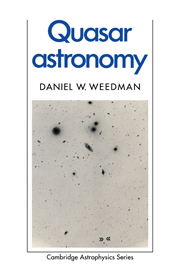6 - Quasar evolution
Published online by Cambridge University Press: 18 December 2009
Summary
Basic test for evolution
Determining whether the properties of the universe have changed as a function of its age is a major concern of observational cosmology. Not without logic, a universe maintaining the same characteristics through all of time has a satisfying nature. If we could understand it now, we would by definition understand it always. Even those who do not adhere to such a steady state universe have been loath to invoke changing characteristics to the observable galaxies in the universe. Another one of the ironies of the history of astronomy is that the cosmological tests utilized to prove that we inhabit an evolving Friedmann universe, tests applied using the bright elliptical galaxies as distance probes for cosmological purposes, could not allow evolution of those same galaxies (Sandage 1961). Constancy of the galaxy properties was a necessary prerequisite to using them for cosmological purposes. It is presumed now that such galaxies do change, even over observable time scales, and our ignorance about the proper evolutionary corrections to apply has removed much of the stimulus for drawing cosmological conclusions (Tinsley 1977).
Yet, astronomers who two decades ago accepted little evolution for galaxies were never hesitant to accept a lot of evolution for quasars. Even now, it is necessary to invoke far more evolution in quasars than in galaxies to explain the data seen. Few are troubled by this inconsistency, but it is not too surprising that some are.
- Type
- Chapter
- Information
- Quasar Astronomy , pp. 115 - 139Publisher: Cambridge University PressPrint publication year: 1986



